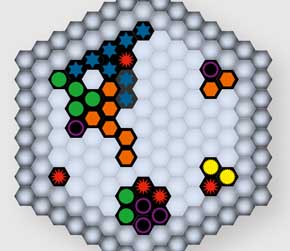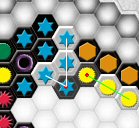AXIO
The game
The goal of the game is to achieve as many points as possible in each of the six colors. It is especially important to ensure that all colors are represented as uniformly as possible, because in the end the color is decisive, which has reached the least points.
Field

The size of the field depends on the number of players: for two players only the inner, bright part is used. With three players, the bright grey margin is added, with four players counting the entire field.

At the top right is the scoreboard of all players. The number of points is displayed graphically by the length of the color beams as well as numerically above.
Game sequence
Each player always has six stones in stock at the beginning of each round. Finished stones are automatically filled after the end of the train.
Players now take reihum a stone from their stock and place in the field. To do this, you click a stone in the selection, if desired, turn it right-click and then place it again, with a click, on the field. If you want to re-decide after selecting the stone, just click another stone of the selection.
In first Each player must put round to one of the starting stones to which no player has created. After the first round, the landing position is exposed.
Each laid stone is immediately evaluated.

Each half of the stone is considered extra: for each identical hexagon bordering the laid stone in a straight line, one gets a point.
In the picture the blue-yellow stone was laid (marked with two red points). The yellow stone now gets two points (green line), the blue three points (two points up, one left).

Here the lower double-orange rod was laid. The right part of the stone now receives four points (violet lines), the left part of the stone two points (green line)

A stone does not bring points for itself, even if it is monochrome (double stone). So if you put the stone as in the picture, you only get one point.

If the player had turned the stone and placed it in such a way that both parts are adjacent to the lying greens, he could have reached two points (red lines), since then both parts would have scored one point.
If a player reaches 18 points in one color, he may place another stone as a bonus. All points that would go beyond the 18 are not evaluated.
If a player at the end of his train from his weakest color has no more tokens in his stock, he gets the opportunity either All to exchange stones in its stock or to retain its stock and only refill them to six stones. If not a single color is the weakest, but several, then you can no longer have stones of these colors on your hand.
Playing
The game ends when no more stone can be laid. The game can also be terminated early when a player manages to in All to reach at least 18 points.
The player who has scored most points with his weakest color has won. At the same time, the color decides with the next higher score, etc.
Options
team
With the /team option, two players can play as a team against another team. This means that players play 1 and 3 together against number 2 and 4. The team partners collect points up to 18. If in a team 18 points are reached in one color for the first time, it will also receive a bonus train; the remaining points over 18 will fail for this train. If the team subsequently makes points in this color, these will continue to be credited up to a score of 36. If the 36 points are reached, there is another bonus.
The conditions of victory remain the same. A premature victory is now of course at 36 and no longer at 18 points in any color.
Solo variant
AXIO can also be played as a solo variant. Just join the game and start as usual. The rules are almost the same as in normal game.
Exceptions:
- you have no six stones to choose from, but always only one
- you play similar to team option up to 36 points
- as with the team option, the remaining points of this course will fall when the 18th limit is reached
At the end, the three weakest colors are used for valuing. If, for example, with its three weakest colors 12, 14 and 18 points, 121418 points are obtained. The aim is to move forward as uniformly as possible.

